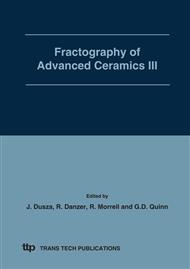p.260
p.267
p.275
p.279
p.283
p.287
p.291
p.295
p.300
Corrosion of Alumina Ceramics in an Aqueous Solution of Sodium Chloride
Abstract:
Two alumina based ceramics with 99.99 % and 95 % of Al2O3 were evaluated after dissolution in an aqueous solution containing 0.5 mol/l NaCl at temperatures of 150 and 200 °C. The weight loss of liquid phase sintered alumina was mainly attributed to congruent dissolution of SiO2 and CaO from grain-boundary amorphous film, which is accelerated at higher temperature, accompanied by precipitation of silicaceous phases from oversaturated solution at 200 °C. Pure polycrystalline alumina corroded by loss of alumina grains, which do not dissolve in the corrosion media.
Info:
Periodical:
Pages:
283-286
Citation:
Online since:
March 2009
Authors:
Keywords:
Price:
Сopyright:
© 2009 Trans Tech Publications Ltd. All Rights Reserved
Share:
Citation:


